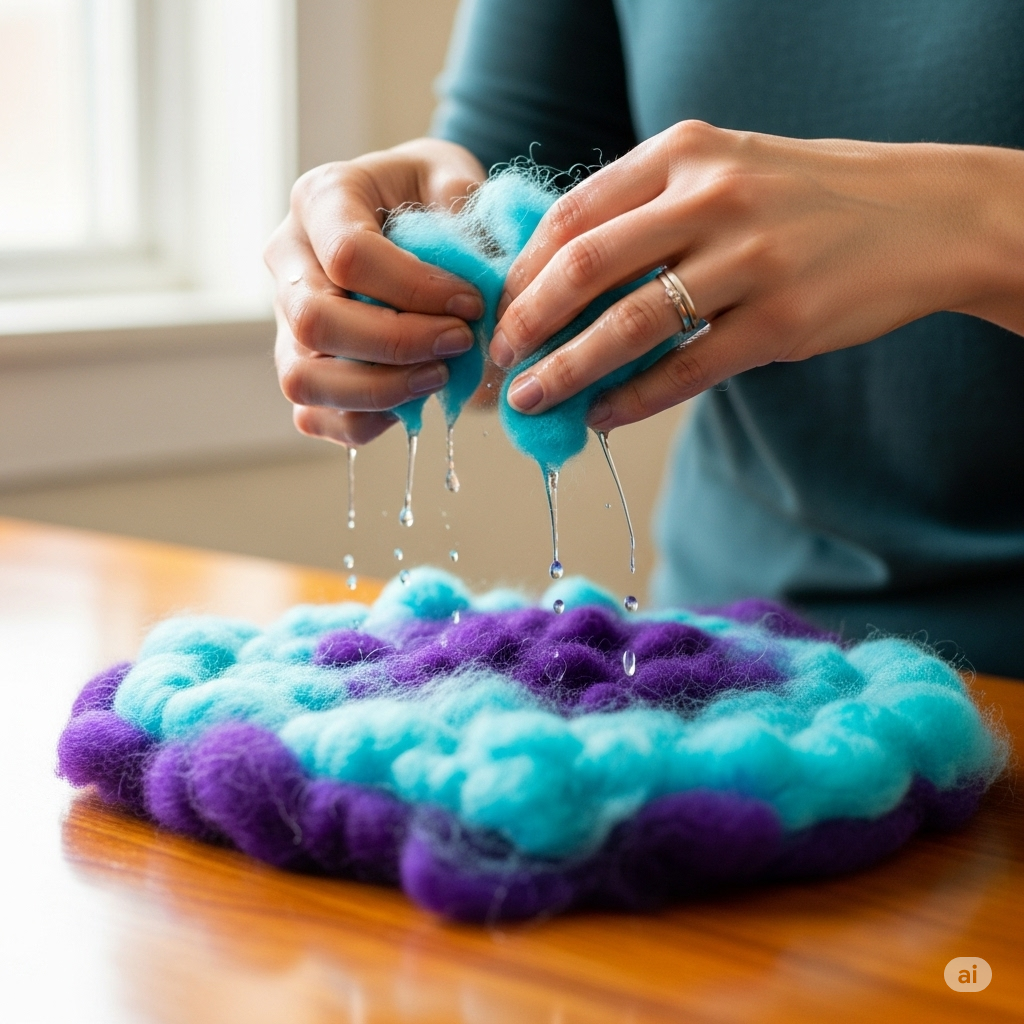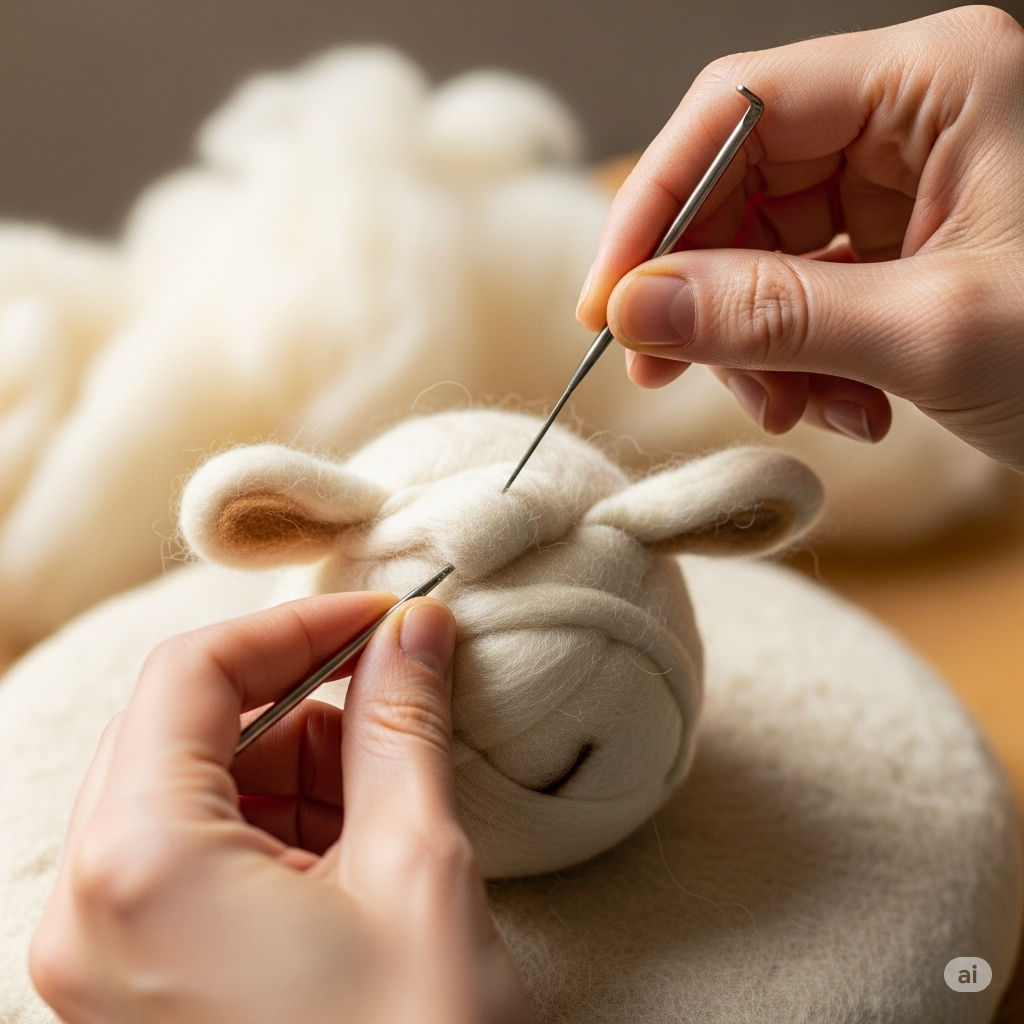
Wet felting is an ancient textile art form that involves transforming wool fibers (or other animal fibers) into a dense, strong fabric called felt. It’s believed to be one of the oldest forms of textile making, possibly predating weaving and knitting, with origins in Central Asia.
How Wet Felting Works:
The process relies on the unique structure of wool fibers, which have microscopic scales. When exposed to hot, soapy water and agitation (friction), these scales open up and interlock, creating a durable, non-woven material. The soap helps the fibers move and slide against each other, while the warmth and friction encourage the scales to bind.
The Basic Process:
- Preparation: Lay out thin layers of wool roving (unspun fibers) in alternating directions (e.g., one layer horizontally, the next vertically). This criss-cross pattern helps the fibers to felt evenly and create a strong fabric.
- Wetting: Apply warm, soapy water to the wool. A mild soap, like olive oil soap or eco-detergent, is commonly used. The water should be warm enough to help open the fiber scales.
- Agitation: Gently press and rub the fibers. Initially, you want to be gentle to avoid disturbing the fiber layout. As the fibers begin to mesh, you can increase pressure and agitation. This can involve:
- Rubbing: Using your hands, often with a piece of netting or bubble wrap over the wool to distribute pressure and prevent sticking.
- Rolling: Rolling the wool up tightly within a mat (like a bamboo mat or bubble wrap) and rolling it back and forth. This is a common and effective method for larger pieces.
- Fulling: Once the fibers are initially interlocked, “fulling” is the process of further shrinking and compacting the felt. This can involve more vigorous rubbing, rolling, or even gently throwing or dropping the felt.
- Testing: Periodically “pinch test” the felt to see if the fibers are holding together. If they are still loose, continue with more agitation.
- Rinsing: Once the desired density is achieved, rinse the felt thoroughly in warm water to remove all soap residue. Finishing with a cold water rinse can help shock the fibers and set the felt.
- Drying: Press out excess water with a towel and then lay the felt flat or hang it to dry.
Materials and Tools:
- Wool roving/fibers: Merino wool is popular for wet felting due to its fine fibers, but other animal fibers can also be used.
- Warm water: Essential for opening the fiber scales.
- Soap: Mild liquid soap or grated olive oil soap flakes.
- Working surface: A flat surface, often covered with bubble wrap (bubbles up) or a bamboo mat, to provide friction and allow water drainage.
- Netting/mesh: A piece of netting (like tulle, gauze, or a laundry bag) to place over the wool during the initial rubbing stages, preventing the fibers from shifting too much.
- Spray bottle or water sprinkler: For even application of soapy water.
- Towels: To absorb excess water.
- Optional tools: Pool noodle (for rolling), fulling blocks, hand carders (for preparing wool), resist materials (for 3D shapes).
Uses of Wet Felting:
Wet felting is a versatile technique used to create a wide range of items, including:
- Apparel: Hats, scarves, slippers, vests, jackets, skirts.
- Accessories: Handbags, purses, pouches, jewelry.
- Home decor: Throw pillows, table runners, coasters, placemats, wall hangings.
- Artistic pieces: 2D “paintings” with fibers, sculptural vessels, decorative items.
- Functional items: Rugs, book covers.
Techniques within Wet Felting:
- Flat felting: Creating flat sheets of felt fabric.
- 3D felting (over a resist): Using a non-felting material (like plastic or foam) as a “resist” to create hollow 3D forms like bowls, vessels, or hats. The wool is laid out around the resist, and as it felts and shrinks, it forms the desired shape.
- Nuno felting: A specialized technique where wool fibers are felted onto an open-weave fabric (like silk, gauze, or linen), creating a lightweight, draped, and often textured fabric.
- Pre-felt: Partially felted wool that can be used as a base for further wet felting or for combining with other materials.
Wet felting offers a tactile and creative way to work with natural fibers, resulting in unique and durable handcrafted items.

 Giriş & Kayıt
Giriş & Kayıt
 Sepet
Sepet

